The Fireworks Galaxy is a bright spiral galaxy located on the border between the constellations Cepheus and Cygnus. It is one of the nearest spiral galaxies to the Sun. It appears face-on near the orange star Eta Cephei. The galaxy has an apparent magnitude of 9.6 and lies approximately 25.2 million light years away. It has the designation NGC 6946 in the New General Catalogue.
The Fireworks Galaxy is classified as an intermediate spiral galaxy, which means that it has a structure that is between that of an unbarred and barred spiral galaxy. Its spiral structure is quite irregular and it has unusual magnetic arms located between the optical ones.
The galaxy has an apparent size of about 11.48 by 10.72 arcminutes in optical wavelengths, but appears considerably larger in radio wavelengths. The Uppsala General Catalogue of Galaxies (UGC) lists a major and minor axis of 14 arcminutes and a photographic magnitude of 10.5 for the galaxy.
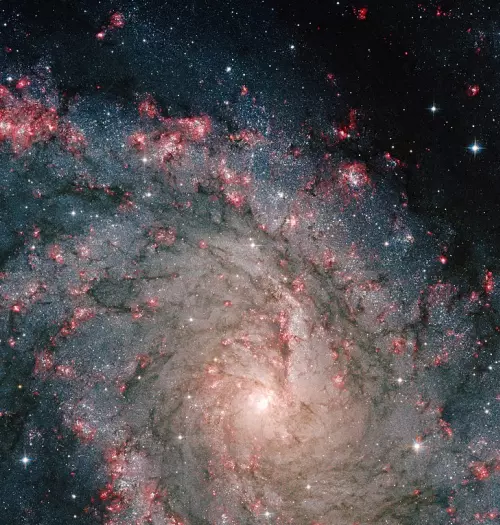
The Fireworks Galaxy (NGC 6946), image: NASA (the Hubble Space Telescope)
NGC 6946 was nicknamed the Fireworks Galaxy because it has hosted 10 supernovae over the last century, which is more than any other known galaxy and ten times the rate seen in the Milky Way. It is classified as an active starburst galaxy, one that has an extraordinarily high rate of star formation. The Fireworks Galaxy is a popular target for astronomers studying the evolution of massive stars, as well as for amateur astronomers looking for bright targets for small and medium telescopes.
Supernovae
The Fireworks Galaxy has hosted a record number of observed supernova events. Ten were detected from 1917 to 2017: SN 1917A, SN 1939C, SN 1948B, SN 1968D, SN 1969P, SN 1980K, SN 2002hh, SN 2004et, SN 2008S, and SN 2017eaw.
SN 1917A
SN 1917A was discovered by the American optician George Willis Ritchey on July 19, 1917. It occurred 37’’ west and 105’’ south of the core of NGC 6946 and peaked at magnitude 13.6. It was classified as a type II supernova, one triggered by a rapid collapse of the stellar core. An analysis of the nearby stars conducted in 2018 suggested that the progenitor star had a mass about 15 times that of the Sun. A 2021 study deduced a mass of 9.3 solar masses.
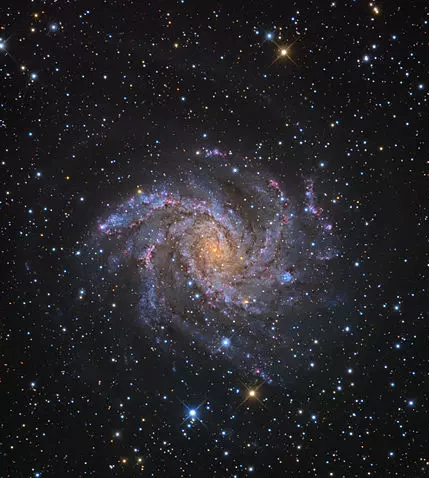
The Fireworks Galaxy, image: Adam Block/Mount Lemmon SkyCenter/University of Arizona (CC BY-SA 4.0)
SN 1939C
SN 1939C was first reported by the Swiss astronomer Fritz Zwicky on July 17, 1939. Zwicky identified it as a type I supernova. It reached a peak visual magnitude of 13.0. The remnant lies 215’’ west and 24’’ north of the galactic core.
SN 1948B
SN 1948B was discovered by the American astronomer Nicholas Mayall east-northeast of the core on June 15, 1948. Mayall had previously demonstrated that the Crab Nebula (Messier 1) in Taurus was the remnant of a historic supernova recorded in 1054. SN 1948B was classified as a type II-P supernova, a core collapse supernova that shows a plateau during the decline.
SN 1968D
SN 1968D was a type II supernova observed on February 29, 1968, that peaked at magnitude 13.5. It was the closest of the historical supernovae to the nucleus. Its discoverers, Wild and Dunlap, reported it to be 45’’ east and 20’’ north of the core.
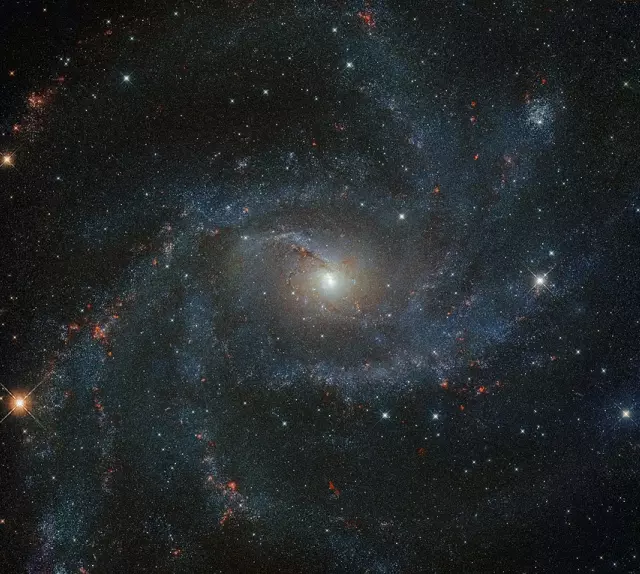
NGC 6946, image: ESA/Hubble & NASA, A. Leroy, K.S. Long (CC BY 2.0)
SN 1969P
The discovery of SN 1969P was reported by Rosino on December 11, 1969. The supernova reached a maximum magnitude of 13.9. Its type was not determined. The remnant is located 5’’ west and 180’’ south of the galactic core.
SN 1980K
SN 1980K is one of the best-studied supernova remnants in the sky. The supernova shone at magnitude 11.4 at peak brightness. It was classified as a type II-L supernova, a core-collapse supernova whose light curve shows a linear (steady) decline after reaching peak brightness. SN 1980K was the brightest of the 10 supernovae seen in the Fireworks Galaxy.
SN 2002hh
SN 2002hh was a type II-P supernova reported southwest of the nucleus on October 31, 2002. Observations in 2004 and 2005 suggested a massive red supergiant or luminous blue variable as the progenitor.
SN 2004et
SN 2004et was a type II-P supernova discovered by Moretti on September 27, 2004. It reached a peak magnitude of 12.7. A study of pre-supernova images of the galaxy revealed that the event occurred on September 22. The same study identified a yellow supergiant with about 15 solar masses as a candidate progenitor. The star may have experienced a red supergiant stage before the supernova event and it may have been part of an interacting binary system that also included a blue supergiant.
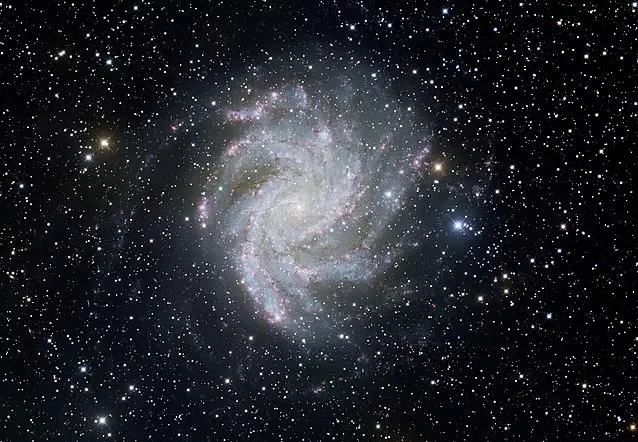
The Fireworks Galaxy (NGC 6946), image: KPNO/NOIRLab/NSF/AURA/T.A. Rector (University of Alaska Anchorage)/H. Schweiker (WIYN) (CC BY 4.0)
SN 2008S
SN 2008S was considerably fainter than other supernovae detected in NGC 6946, peaking at magnitude 17.6. A 2009 study suggested that it was an electron capture supernova, an event that occurs to stars with 8 to 10 solar masses, when neon inside them eats so many electrons in the core that it causes the core to collapse, triggering a supernova.
SN 2017eaw
The supernova SN 2017eaw was discovered at magnitude 12.8 on May 14, 2017. It was classified as a type II-P supernova. A 2019 study determined a mass of 15-16 solar masses for the red supergiant progenitor. The supernova was first reported by the American amateur astronomer Patrick Wiggins.
Failed supernova: N6946-BH1
The Fireworks Galaxy hosted a disappearing supergiant star, designated N6946-BH1, that is believed to have faded as a result of a failed supernova. The star’s bolometric luminosity spiked to a million or more solar luminosities in the spring of 2009, but by 2015 the supergiant became invisible in optical wavelengths. The increase in luminosity was insufficient for a supernova and the star is believed to have collapsed to form a black hole. N6946-BH1 has been extensively studied because it provides evidence for the theory that exceptionally massive stars can collapse into black holes without undergoing supernova events.
N6946-BH1 was first detected in 2015, when a team of researchers reported a disappearing star in the Fireworks Galaxy as a failed supernova candidate. The team observed 27 galaxies using the Large Binocular Telescope for four years in search of massive stars that collapsed to form black holes without producing supernova events. The candidate, designated N6946-BH1, was reported to have an estimated mass between 18 and 25 solar masses.
In 2017, the team confirmed the optical disappearance of the star based on observations with NASA’s Hubble Space Telescope. The star, a red supergiant with a mass about 25 times that of the Sun, had exhibited an outburst in 2009 during which it became more than a million times as luminous as the Sun. The Hubble images showed the star to be at least 5 magnitudes fainter in optical wavelengths, and its bolometric luminosity at least six times fainter than the progenitor’s. Faint emission in the near-infrared band was detected that was believed to be associated with the source. The study suggested that the rapid decline was the result of a failed supernova caused by the core-collapse of a red supergiant star to a black hole. The pre-collapse light curve showed a decrease in optical brightness starting in mid-2008, during which the star became noticeably redder.
A 2019 study proposed that the progenitor was a yellow hypergiant with a surface temperature of about 5,000 – 6,000 K, that was experiencing high mass loss prior to the collapse.
If the researchers are correct in concluding that the event was a failed supernova, this was the first time that black hole formation was observed.
Facts
The Fireworks Galaxy was discovered by William Herschel on September 9, 1798. At the time of discovery, Herschel believed the object to be a gaseous nebula. It was one of about 5,000 nebulous objects he and his son John Herschel discovered. The true nature of galaxies was not confirmed until the early 20th century.
The galaxy is catalogued as Caldwell 12 in the Caldwell catalogue of 109 deep sky objects easily observed in amateur telescopes, compiled by the English amateur astronomer Sir Patrick Moore.
The Fireworks Galaxy was once believed to a member of the Local Group of galaxies, but is now known to lie beyond it. It does, however, lie within the Virgo Supercluster, which contains both the Local Group and the Virgo Cluster. Even though it was sometimes also listed as a member of the Virgo Cluster, NGC 6946 is one of the isolated galaxies in the Virgo Supercluster. It has not been associated with any of the galaxy groups in our neighbourhood.
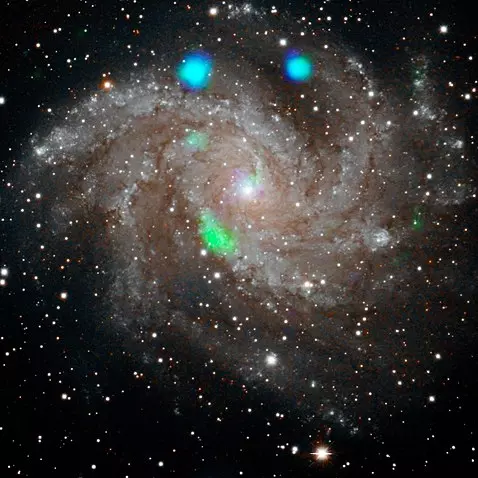
This visible-light image of the Fireworks galaxy (NGC 6946) comes from the Digital Sky Survey and is overlaid with data from NASA’s NuSTAR observatory (shown in blue and green). Blue light indicates X-rays captured during the first of two observations by NuSTAR, in May 2017. Green light indicates X-rays seen less than two weeks later in the second observation. This means that the source of the green spot to the lower left of the galactic center began radiating in the time between those two observations. Two bright sources near the top of the image show a combination of blue and green, indicating those sources were visible during both observations. The X-ray data don’t have the same spatial resolution as the visible-light image, so the X-ray sources appear larger. NuSTAR is a Small Explorer mission led by Caltech in Pasadena and managed by NASA’s Jet Propulsion Laboratory, also in Pasadena, for NASA’s Science Mission Directorate in Washington. Image: NASA/JPL-Caltech
The galaxy hosts several unusual objects. These include long regions in the galaxy’s spiral arms that appear to not have any stars or hydrogen gas, two unusual nebulous dark lanes, and the so-called Hodge’s Complex and the Red Ellipse.
Regions devoid of stars and gas are not unusual in spiral galaxies, but some of those observed in NGC 6946 are enormous, with diameters of up to 2 kiloparsecs (6,523 light years). The sizes of these regions are a puzzle to astronomers because the sources of pressure that formed the holes in the disk are uncertain. Various studies have suggested supernova outbursts, stellar winds, the collision of gaseous clouds within the galaxy, and dark matter mini-haloes passing through the disk.
The unusual sets of dark lanes lie north of Hodge’s Complex. They consist of a peculiar arrangement of dark spots and two sets of crossed dark lanes in the vicinity.
Hodge’s Complex
Hodge’s Complex was named after the American astronomer Paul W. Hodge, who discovered it in 1967. Hodge described the object as a possible super-supernova remnant. The complex includes a young supercluster of supergiant stars, about two dozen smaller clusters, and many young, exceptionally luminous stars with ages between 5 and 30 million years.
The complex may in fact be a dwarf galaxy that is interacting with its larger spiral neighbour. It is located in the outskirts of the Fireworks Galaxy.
Red Ellipse
The Red Ellipse is an enormous object that looks like a giant supernova remnant. Its major axis stretches 300 parsecs (978 light years) across. The object lies within the galaxy’s northern spiral arm and is larger than all the observed supernova remnants in NGC 6946. Its name was proposed in a 2016 study that came to the conclusion that it could not in fact be a supernova remnant. The emission-line spectrum indicates photoionization by young, very hot stars, which suggests that the Red Ellipse may be a super-bubble created by a cluster of massive stars located in the northeast portion of the object. However, the cluster itself does not appear large enough to be responsible for the giant super-bubble.
Location
The Fireworks Galaxy is easy to find because it lies near the House of Cepheus, a relatively bright asterism that dominates the constellation Cepheus. The House is found just above the more prominent W of Cassiopeia. A line extended from Schedar through Caph (the right stars of the W) leads to Alderamin (Alpha Cephei, mag. 2.51), the brightest star in Cepheus, which sits at the base of the House. The orange subgiant Eta Cephei (mag. 3.426) lies just west of Alderamin and the Fireworks Galaxy is found about 2 degrees southwest of Eta Cephei.
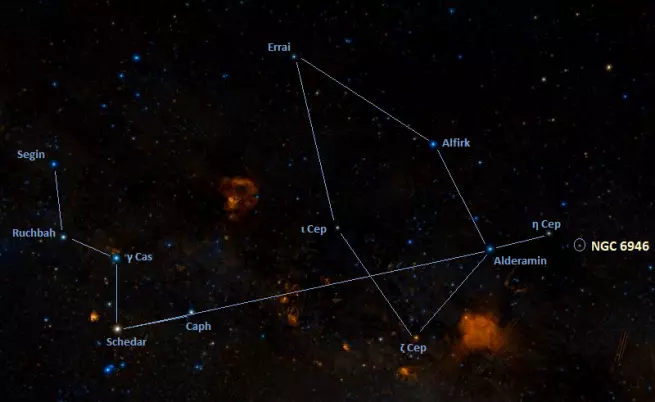
Fireworks Galaxy location, image: Wikisky
The bright (mag. 7.8) open cluster NGC 6939 lies only two thirds of a degree northwest of the galaxy and can be seen in the same field of view. Both objects can be glimpsed in larger binoculars and observed in small telescopes.
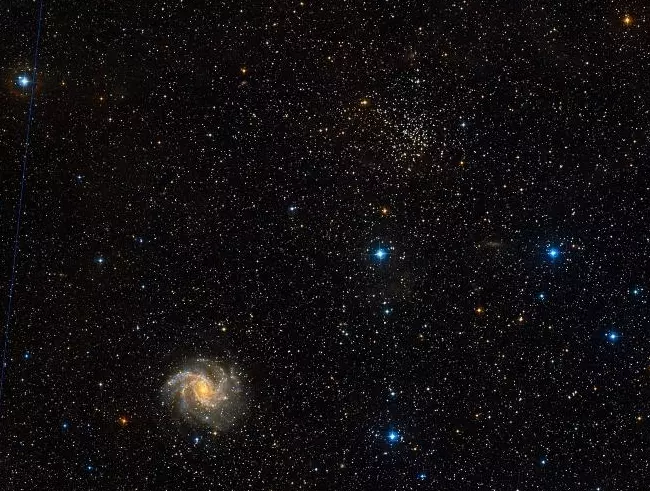
Fireworks Galaxy and NGC 6939, image: Wikisky
For northern observers, Cepheus is visible throughout the year. The best time of year to observe the Fireworks Galaxy and other deep sky objects in the constellation is during the month of November, when the constellation is high above the horizon in the evening.
Fireworks Galaxy – NGC 6946
| Morphological type | SAB(rs)cd |
| Constellation | Cepheus, Cygnus |
| Right ascension | 20h 34m 52.332s |
| Declination | +60° 09′ 13.24″ |
| Distance | 25.2 ± 1.0 million light years (7.72 ± 0.32 megaparsecs) |
| Apparent magnitude | 9.6 |
| Apparent size | 11.48 x 10.72 arcminutes |
| Redshift | 0.000133 |
| Helio radial velocity | 48 ± 2 km/s |
| Names and designations | Fireworks Galaxy, NGC 6946, Caldwell 12, Arp 29, UGC 11597, PGC 65001, MCG +10-29-006, NVSS J203452+600916, CGCG 304-006, CGCG 2033.8+5959, IRAS 20338+5958, IRAS 20338+5959, IRAS F20338+5958, 2MASX J20345233+6009132, RX J2034.9+6010, BWE 2033+5958 |